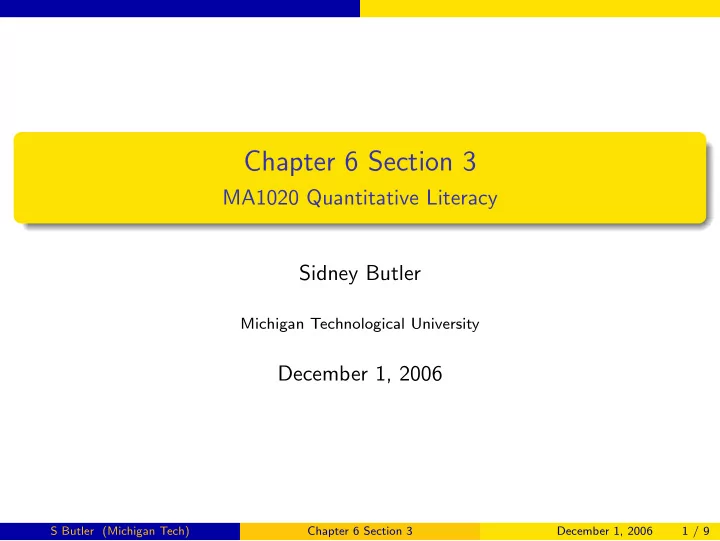

Chapter 6 Section 3 MA1020 Quantitative Literacy Sidney Butler Michigan Technological University December 1, 2006 S Butler (Michigan Tech) Chapter 6 Section 3 December 1, 2006 1 / 9
Hamiltonian Paths and Circuits Definition A Hamiltonian path is a path that visits each vertex in a graph exactly once. If the Hamiltonian path begins and ends at the same vertex, the path is called a Hamiltonian circuit. Example Are the paths below Hamiltonian Paths, Euler paths, both, or neither? S Butler (Michigan Tech) Chapter 6 Section 3 December 1, 2006 2 / 9 DABCE
Complete Graphs Definition A complete graph is a graph in which every pair of vertices is connected by exactly one edge. Example 1 Draw a complete graph with 6 vertices. 2 Count the number of edges in the graph. Theorem (Number of Edges in a Complete Graph) A complete graph with n vertices has n ( n − 1) edges. 2 S Butler (Michigan Tech) Chapter 6 Section 3 December 1, 2006 3 / 9
Hamiltonian Paths in a Complete Graph Example Find all the Hamiltonian paths and all the Hamiltonian circuits in the graph. Theorem (Number of Hamiltonian Paths in a Complete Graph) The number of Hamiltonian paths in a complete graph with n vertices is n ! . The number of Hamiltonian circuits in a complete graph with n vertices is also n ! . S Butler (Michigan Tech) Chapter 6 Section 3 December 1, 2006 4 / 9
Traveling-Salesperson Problem Definition The cost of a path in a weighted graph is the sum of the weights assigned to the edges in a path. When costs are assigned to each edge in a complete graph, the graph is called a complete weighted graph. S Butler (Michigan Tech) Chapter 6 Section 3 December 1, 2006 5 / 9
Example #28 1 List all possible Hamiltonian circuits. 2 Compute the cost of each circuit and find the circuit of least cost. 3 Identify all pairs of mirror-image Hamiltonian circuits. How do the costs of mirror-image Hamiltonian circuits compare? S Butler (Michigan Tech) Chapter 6 Section 3 December 1, 2006 6 / 9
Approximation Algorithms Definition An approximation algorithm is on an algorithm that, for most complete weighted graphs, will find a Hamiltonian circuit that is either the least-cost Hamiltonian circuit or is one that is not much more costly than the least-cost Hamiltonian circuit. Nearest-Neighbor Cheapest-Link S Butler (Michigan Tech) Chapter 6 Section 3 December 1, 2006 7 / 9
Nearest Neighbor Algorithm 1 Specify a starting vertex. 2 If unvisited vertices remain, go from the current vertex to the unused vertex that gives the least-cost connecting edge. 3 If no unvisited vertex remains, return to the starting vertex to finish forming the low-cost Hamiltonian circuit. S Butler (Michigan Tech) Chapter 6 Section 3 December 1, 2006 8 / 9
Cheapest-Link Algorithm 1 In the beginning, all edges are acceptable and no edges have been selected. 2 From the set of acceptable edges, select the edge of smallest weight. If there is a tie, select any of the edges with the smallest weight. 3 If the selected edges do not form a Hamiltonian circuit, then determine the set of acceptable edges. Unacceptable edges are those that either share one vertex with two selected edges or that would close a circuit that is not a Hamiltonian circuit. Repeat step 2. 4 If the selected edges form a Hamiltonian circuit, that circuit is your low-cost Hamiltonian circuit. S Butler (Michigan Tech) Chapter 6 Section 3 December 1, 2006 9 / 9
Recommend
More recommend